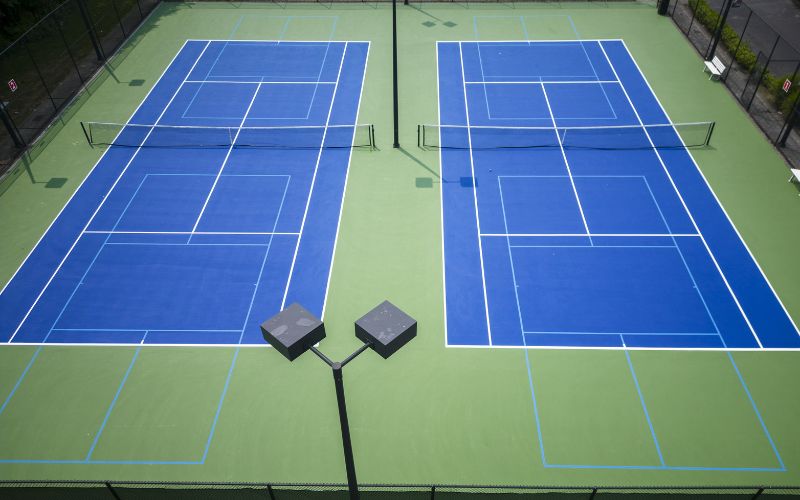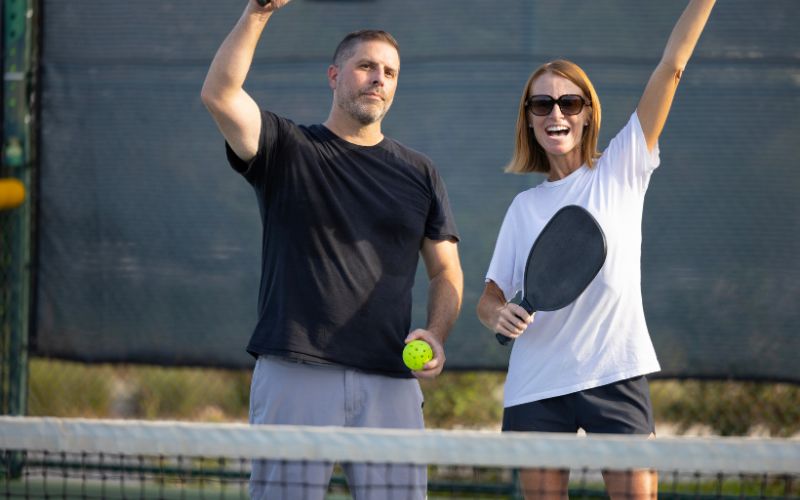What is a Pickleball Game? A Comprehensive Overview
What is a Pickleball Game? A frequent inquiry among newcomers getting acquainted with this sport. Pickleball is a rapidly growing sport that has captured the hearts of many fitness enthusiasts and recreational players across the United States and around the world. In this comprehensive guide, we will delve into the intricacies of this exciting game, from the pickleball court to the rules of play. Whether you’re a seasoned pickleball player or a complete newbie, this article will provide you with valuable insights and information. So, let’s get started!
The Origin of Pickleball
Pickleball, often referred to as “the fastest growing sport in America,” has a fascinating history. The game called pickleball was created in 1965 by a trio of friends: Joel Pritchard, Bill Bell, and Barney McCallum.
It all began on Bainbridge Island, Washington, when these three gentlemen were looking for a way to keep their families entertained. They improvised a game by using some simple equipment they had on hand – a wiffle ball, table tennis paddles, and the same size as a badminton court.
The Pickleball Court
One of the defining features of pickleball is its court, which bears some resemblance to a tennis court. A standard pickleball court is 20 feet wide and 44 feet long for doubles play. However, for singles play, the court is narrowed to 20 feet wide and 22 feet long. The court is divided into several key zones, and it’s important to understand them for successful play.
The Serving Team’s Side
On one side of the pickleball court which is called the serving court, you have the serving team. This is where the action begins. When playing pickleball, only the serving team is responsible for initiating the game, and their objective is to serve the pickleball to the opposing team.
The Receiving Team’s Side
Opposite the serving team is the receiving team’s side. Players on this side of the court receive the serve from the serving team and return the ball over the net. This is where the game truly unfolds, with fast-paced volleys and strategic shots.
The No-Volley Zone
Pickleball has a unique “no-volley zone,” also known as the kitchen. This area extends 7 feet from the net into the court and is a non-volley zone. This means players cannot hit the ball out of the air (volley) when they are standing in this zone. Understanding and respecting this rule is vital for successful play.
The Volley Zone
The area outside the no-volley zone is known as the volley zone. Here, players can execute volleys and hit the ball out of the air. Mastering this area is essential for skilled pickleball play.
How to Play Pickleball
Pickleball can be played as a singles or doubles match, utilizing the same court size for both formats. Singles and doubles matches share fundamental similarities, although there are minor variations in serving regulations and scoring methods.
At its core, the game is played as follows: One of the picklers (an informal term for players) initiates the game by serving the ball underhand, directing it diagonally across the net into the opposing player’s service court.
Subsequently, the ball is volleyed back and forth over the net until a player fails to return it. Points are exclusively earned by the serving team, and each game is played up to 11 points. However, to secure a victory, you must maintain a lead of at least two points.
The no-volley zone, known as the “kitchen,” is a critical element of the game, situated 7 feet from the net on both sides. Players are not allowed to volley the ball within this designated zone.
In a typical “tournament” setting, matches are structured as three-game sets. However, depending on the specific venue or setting, alternative formats, such as round-robin matches or challenge courts (where a player remains on the court until they lose a game), may also be adopted. If you’re not playing at a formal pickleball club, you have the flexibility to select the match format that suits your preferences.
For an in-depth understanding of the official rules and guidance on scoring in singles versus doubles matches, you can refer to the USA Pickleball Rules Summary page.
Understanding Pickleball Rules
To initiate play, it’s essential to serve the ball using an underhand technique while keeping it below waist level. The serve should follow a diagonal path across the court and must make contact with the ground before the opposing player can return it.
Scoring in pickleball is exclusive to the serving team, and the game is played up to 11 points. It’s crucial to emphasize that securing a victory necessitates a lead of at least two points.
Upon scoring a point, the serving team undergoes a side-switching, resulting in the server’s transition from the right side to the left.
The “kitchen,” also recognized as the no-volley zone, is an area extending 7 feet from the net. Players are restricted from executing volleys within this defined zone.
Serving in Pickleball
The game begins with a serve, and it’s crucial to understand the rules and strategies for effective serving. The serving team must serve diagonally to the receiving team. The serve must clear the no-volley zone and land in the opposing service court. A point is scored when the serving team wins a rally, and the receiving team commits an error.
The Two-Bounce Rule
Pickleball is unique in that it employs a “two-bounce rule.” This means that the ball must bounce once on each side before players are allowed to volley it. After the two bounces, players can execute volleys, adding an exciting element to the game.
Scoring in Pickleball
Pickleball uses a simple scoring system. The serving team’s score is always called first, followed by the receiving team’s score. Points are scored on each serve, and the first team to reach 11 points (with a lead of at least two points) wins the game.
What has caused the sudden surge in pickleball popularity?
It experienced an astronomical rise, with the COVID-19 pandemic having no adverse impact on its growth.
According to Laura Gainor, the Director of Media Relations for USA Pickleball, the pandemic prompted many Americans to seek ways to stay healthy and active close to their homes. The compact size of a pickleball court, just a quarter of that of a tennis court, made it convenient for people to set up a court in their driveways, parking lots, or indoor gym spaces. This led to numerous individuals being introduced to the sport during these unprecedented times, often engaging in matches with their family of four right in their driveways.
Remarkably, even before the pandemic, the popularity of pickleball was steadily on the rise. In fact, over the past five years, the number of participants has doubled. Many players laud pickleball as an excellent workout that doesn’t feel like a traditional exercise routine. Furthermore, pickleball is believed to be gentler on the body, particularly the hips and knees, in comparison to tennis and other racquet sports.
Another significant attraction is the inclusivity of the game. “The game is multi-generational, so we’re witnessing grandparents playing alongside their grandkids, while young adults in their 20s and 30s enjoy the sport with their parents,” highlights Gainor.
Pickleball vs. Badminton, Tennis and Ping Pong
Pickleball has often been compared to other racquet sports like tennis, ping pong, and badminton. Let’s take a closer look at how it differs and what makes it unique.
Pickleball vs. Tennis
While both pickleball and tennis are racquet sports, they have distinct differences. Tennis courts are significantly larger, and the rules of play are more complex. Pickleball is a more accessible sport for beginners due to its smaller court and simplified rules.
Pickleball vs. Ping Pong
Ping pong, or table tennis, is another racquet sport that shares some similarities with pickleball. Both games involve quick reflexes and volleying the ball over a net. However, pickleball games are typically played on a larger court and with a wiffle ball, while ping pong is played on a smaller table with a lightweight ball.
Pickleball vs. Badminton
Badminton and pickleball both use a net and a court, but they have significant differences in terms of court size, equipment, and rules. Pickleball courts are smaller, and the game is often played with hard paddles and a plastic ball, while badminton uses shuttlecocks and racquets.
The Equipment:
Pickleball paddles are designed with a flat shape and rounded edges, closely resembling an oversized ping-pong paddle. Although they were initially crafted from wood, modern versions are constructed using a variety of advanced lightweight materials such as carbon fiber, polypropylene, and graphite. A typical paddle measures 16 inches in length, 8 inches in width, and is typically around half an inch in thickness.
Balls
Certain specifications apply to the plastic ball employed in pickleball. Its diameter should fall within the range of 2.76 to 2.98 inches, and its weight should range between 0.780 and 0.935 ounces.
Regarding the color of standard pickleball balls, there are no restrictions; they can be of various colors as long as the entire ball is a single, solid color.
Nets
In contrast to tennis nets, the conventional pickleball nets are slightly lower and notably shorter. Given that pickleball courts are only 20 feet in width, these nets have a width of 22 feet and stand at a height of 36 inches at their poles. They exhibit a sag of 2 inches, which brings the central height down to 34 inches.
Portable pickleball nets are a valuable asset as they allow for versatile game setups in various locations. You can adapt existing tennis, basketball, or badminton courts into impromptu pickleball playing areas using these portable nets.
Pickleball: A Versatile Sport
Pickleball is a versatile sport that can be played in various settings, from casual games in the backyard to competitive pickleball tournaments. It appeals to players of all ages and skill levels, making it a sport for everyone.
Professional Pickleball and Major League Pickleball
In recent years, professional pickleball and major league pickleball have gained significant attention. Major League Pickleball is an organized league that hosts professional tournaments and showcases the highest level of play. Talented athletes are emerging as the faces of professional pickleball, bringing new levels of competition to the sport.
The International Federation of Pickleball
Pickleball’s popularity has transcended borders, and it’s played in many countries around the world. The International Federation of Pickleball (IFP) is responsible for governing and promoting the sport on an international level, much like how other sports are overseen by their respective governing bodies.
Pickleball’s Journey Towards Becoming an Olympic Sport
Pickleball enthusiasts dream of seeing their beloved sport make its debut in the Olympics. While it hasn’t happened yet, there is a growing movement to get pickleball recognized as an Olympic sport. With the sport’s rising popularity and competitive nature, it’s not entirely out of the realm of possibility.
The Future of Pickleball
As pickleball continues to gain traction, it’s safe to say that this sport has a bright future. Its unique blend of elements from other racquet sports, combined with a community of passionate players, makes it a game that’s here to stay. Whether you’re a competitive tennis player looking for a new challenge or someone searching for a fun way to stay active, pickleball has something to offer.
Common Pickleball Injuries
Like any sport, pickleball carries a risk of injuries, although they tend to be relatively minor compared to more high-impact sports. Common pickleball injuries include strains, sprains, and overuse injuries, often affecting the shoulders, wrists, or knees. It’s crucial to stay mindful of your body and use proper techniques to minimize the risk of injury.
Pickleball is a game that has captivated the hearts of many. With its intriguing history, simple rules, and the thrill of competition, it’s no wonder that pickleball is often described as the fastest growing sport in America. So, if you’re looking for a new and exciting sport to dive into, grab your pickleball paddle and head to the court – a world of fun and adventure awaits you!
FAQs About Pickleball:
1. What are the origins of pickleball, and how did it get its name?
Pickleball originated in 1965 when Joel Pritchard, Bill Bell, and Barney McCallum created the game on Bainbridge Island, Washington. The name “pickleball” allegedly came from the Pritchard family dog, Pickles, who chased after the ball during the early matches.
2. Can you explain the “no-volley zone” in pickleball and its significance?
The “no-volley zone,” also known as the kitchen, extends 7 feet from the net. Players cannot hit the ball out of the air (volley) while standing in this zone. Understanding and respecting this rule is crucial as it impacts gameplay strategy and shot selection.
3. How is pickleball scoring different from other sports?
In pickleball, only the serving team can earn points, and games are played up to 11 points. To win, a team must maintain a lead of at least two points. Additionally, scoring occurs on every serve.
4. What equipment is required to play pickleball?
The essential equipment for pickleball includes a paddle (typically made of lightweight materials like carbon fiber) and a plastic ball with specific diameter and weight requirements. Additionally, pickleball courts feature slightly lower nets than tennis courts.
5. What has contributed to the surge in pickleball’s popularity?
The rapid growth of pickleball can be attributed to various factors, including its accessibility, especially during the COVID-19 pandemic, its appeal to multi-generational players, and its reputation as a low-impact yet engaging sport that offers a great workout.







